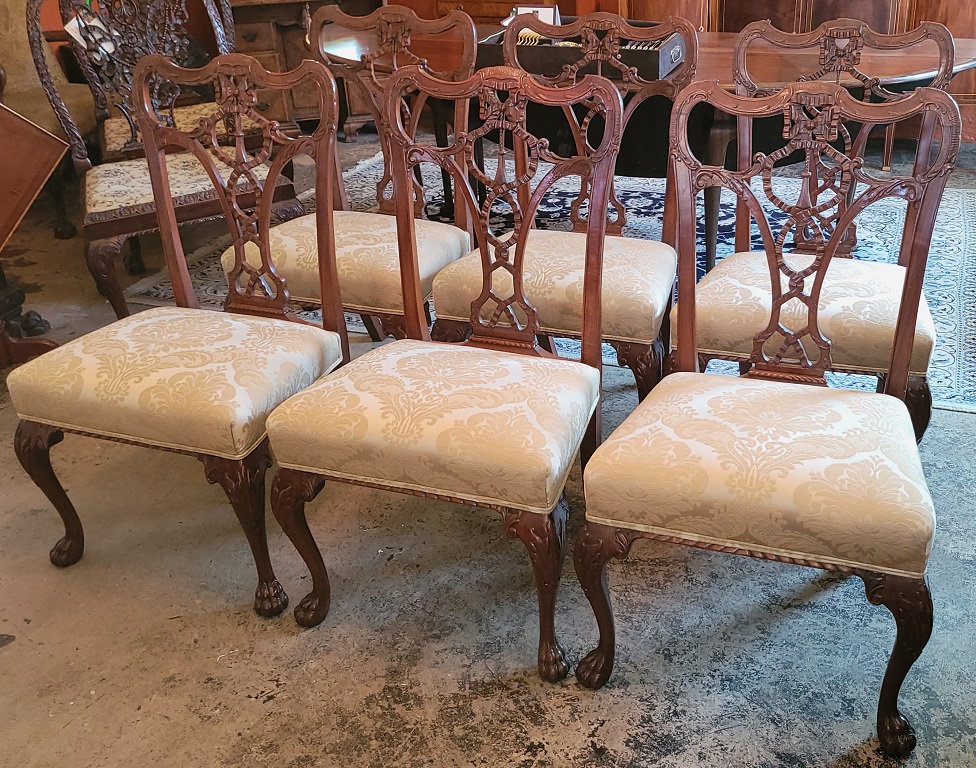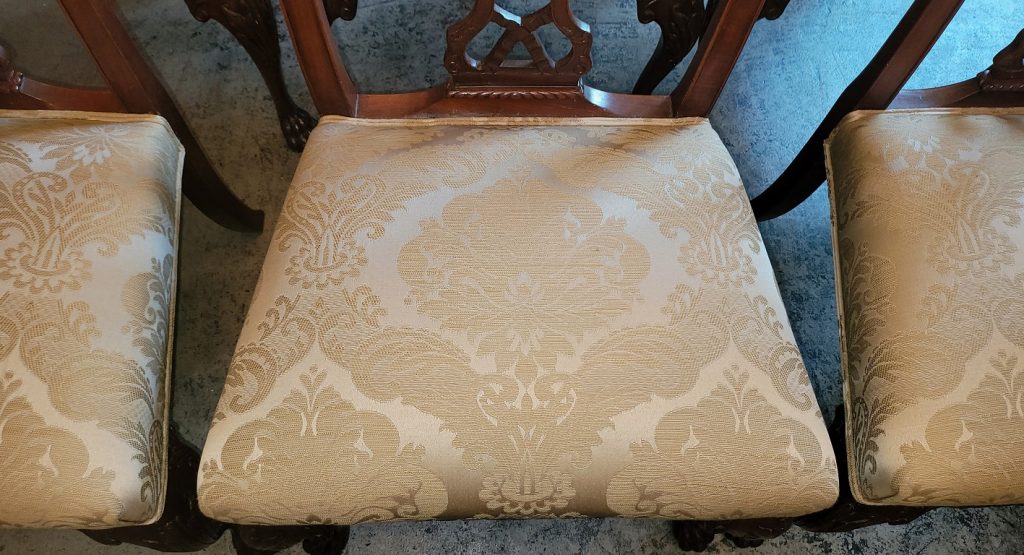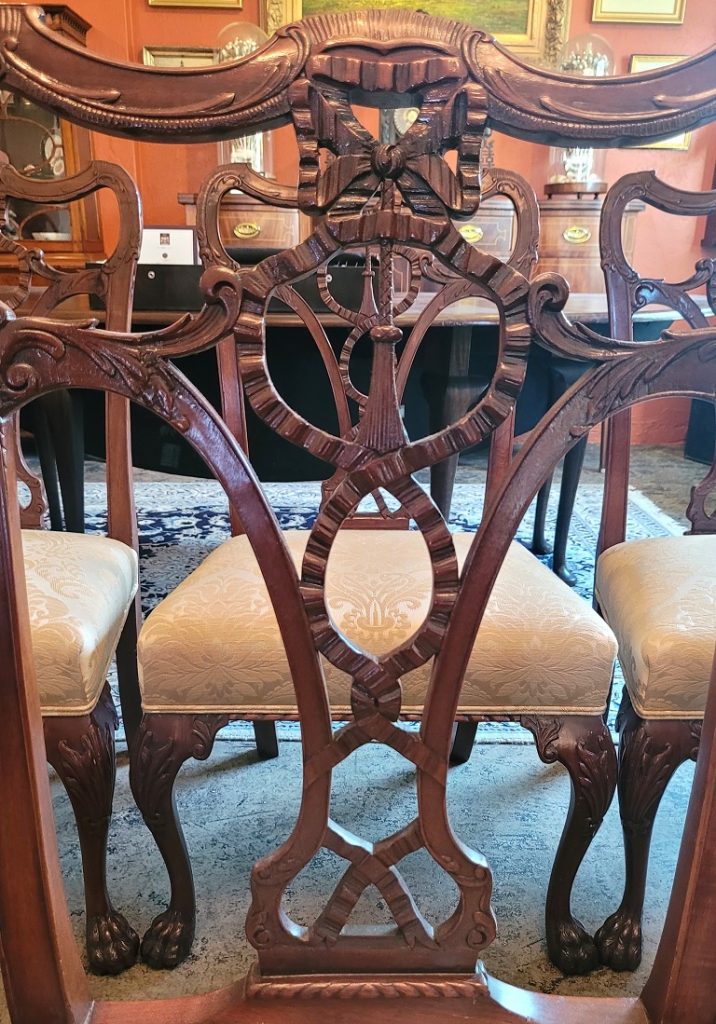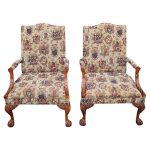19C Set of 6 Irish Chippendale Style Ribbon Back Dining Chairs
PRESENTING a FABULOUS 19C Set of 6 Irish Chippendale Style Ribbon Back Dining Chairs.
Irish made circa 1840-60.
We know that these are Irish due to the signature ‘hairy paw’ feet which is synonymous with Irish Georgian furniture that were made in the Chippendale Style.
These are hand crafted chairs, made of mahogany, and have fabulously detailed ‘Ribbon’ backs splats with tassel, acanthus floral and bow details.
All 6 have been re-upholstered by us in a gorgeous tan/light gold silk damask fabric which is beautifully sympathetic to the style and period.
We are confident that these are Early to Mid 19th Century chairs for a number of reasons: (1) The are hand crafted, (2) the color/patina is what you would expect with natural aging, (3) they have evidence of historic repairs, wear and tear consistent with age, (4) when we removed the old upholstery fabric, which looked like it was done in the 1980’s, we discovered the original ‘horse hair’ cushion filling … this practice stopped in the early 20th Century. The seat webbing was also much older and needed replacing.
Fabulous acanthus carving on the knees of the front legs, with curved legs leading down to the fabulously carved hairy paws.
Nice indented decoration on the front of the seat.
The rear legs are undecorated and curve outwards for additional support and stability.
Unsigned and unmarked but undoubtedly made by a top Irish furniture maker .. probably in Dublin.
SO RARE … SUCH QUALITY … EXCEPTIONALLY IRISH ANTIQUES !
Condition: Each chair has been newly re-upholstered and seat webbing replaced. The original horse hair cushion filling was cleaned and incorporated into the new cushion with modern foam to create a more comfortable and uniform seat cushion, but still retaining originality.
Each chair has signs of historic repairs to the ribbon back splats over the generations. This is not unusual due to the somewhat delicate nature of these types of back splats. Also, it is an indicator of true age. The chair to the back left in the main photos has had the most repairs and much more recently performed (by us) as the back splaty was broken in 2 places (but we had the original pieces) and the chair needed the insertion of metal pins to secure the repaired sections. We have provided a couple of photos of this back splat which you can see evidence of the repairs.
The repairs are very professionally done and the chair is now fully functionable and usable and the repairs are not very noticeable.
These repairs are reflected in the pricing, as, if these chairs were ‘mint’ they would be very valuable and expensive !
Irish furniture can be recognised by certain features, which differentiate it from its European counterparts. The Irish style of furniture is said to have been lagging behind in fashion compared to English equivalent by a number of years, in both its design and manner by which the furniture was manufactured. A defining feature of the mid-eighteenth-century furniture is the carving on different parts of the furniture such as the aprons, blanket chests, bottle-stands and such objects. The carvings included foliated details, baskets of flowers and scallop shells, which are some of the most prominent carvings that are represented on Irish furniture at this time. A few of the Irish makers of these objects were James Hicks, Arthur Jones, William Moore, Mack & Gibton and Robert Strahan. All though individuals would have been the most prominent at the time of the 18th century and early 19th century but there are any other cabinet makers as well.
Not all Irish furniture was detailed with such wonderful carvings and some might have been seen to be rather plain. One of the most identifiable items that are described as plain is the Irish Hunt Table, its simple elegance comprising of with straight plain legs. It was most commonly used in the dining room of a rural house such as a agents house or large house of a land holder. Another very popular and simply designed piece was the Irish Silver table, its design is very elegant and yet individual partially owing to the shell motive.
Other examples of such Irish tables are side tables which have a distinctive double scrolled leg. Usually legs are carved with acanthus and have paw feet which are quite popular in Ireland but more rare in England. Other features are the inside leg which is carved with elongated C-scroll. The triple scroll on the leg was common place. Some cabinet makers and creativity was really captured with their side tables in how the carving was done. This carving may include Jupiters eagle or Lion mask and flanked Swags of flowers. In other furniture such as chairs, the H-shaped serpentine stretcher was popular in the 18th century in Ireland and when English chairs had moved forward in their design the Irish makers were still using the H-shaped serpentine. There was certainly an overlap between Irish and English furniture, one can see that Irish cabinet makers used English pattern books but used Irish features such as the carvings as the shell, baskets of flowers and foliated details. Another unique feature in Irish cabinet making was Killarney ware, its Arbutus wood unique to Killarney County Kerry and how the inlay was designed was unique in the mid 19th century period and in Irish cabinet making. These creations made the Irish furniture unique throughout the 18th, 19th and early 20th century.
19C Set of 6 Irish Chippendale Style Ribbon Back Dining Chairs
Provenance: From an Irish American Estate in Virginia.
Condition: Good original condition, with some historic and more recent professional repairs (see full listing).
Dimensions: Each Chair is 39″ Tall, 22″ Deep and 24″ Wide
Seat Height is 19 inches
Seat Cushion is 17 inches wide at front.
Depth of seat Cushion is 22 inches
SALE PRICE NOW: $14,000 (Set of 6)

















































